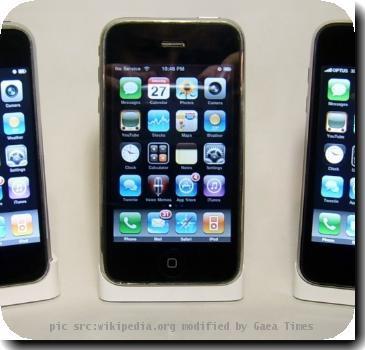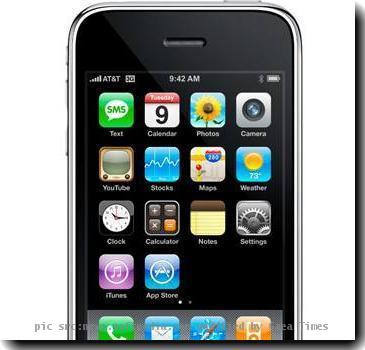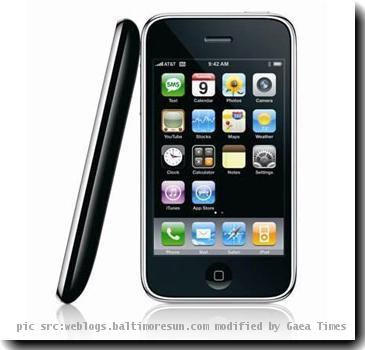Insanely great: iPhone’s cool factor proves stronger than the lure of rival phones’ features
By Jessica Mintz, APTuesday, May 18, 2010
Apple’s iPhone does well without being the best
SEATTLE — It’s been three years, an eternity for gadgets, since Apple Inc. unveiled the iPhone, and by now other phones do some things better. Yet Apple is selling more iPhones than ever.
What is it about the iPhone? Its success shows how Apple has triumphed at two crucial qualities: status and simplicity. And it’s a reminder that while intense Apple fans will obsess over the upgrades the iPhone is expected to get this summer, such details won’t matter as much to everyday buyers.
Other phones have higher-resolution cameras and can shoot high-definition video. The processor seems faster in new phones such as the Droid Incredible. A more energy-efficient touch-screen technology is eclipsing the one used in the iPhone screen. And competitors are matching features that once set the iPhone apart, including its slim shape and its store with thousands of applications and games.
“This thing is not state of the art,” says ABI Research analyst Michael Morgan.
But whether the iPhone has the best technology doesn’t seem to be the question most people ask.
Instead, many people crave the aura of cool that iPhones seem to convey.
“When you see people with them, I’m like, ‘Oh, OK, they get it,’” says Jason Sfetko, a designer at Complex magazine in New York. When he sees someone with a BlackBerry, “I might think, maybe they’re an accountant or something. They’re answering too many e-mails.”
The allure extends to China, where Apple started selling iPhones in October. “I’m quite amazed about what the iPhone has achieved,” says Deng Jinchun, a manager at Jing Lang, a large iPhone retailer in China’s Hunan province. With slight changes, “Apple has been selling the same phone for about three years and the sales are still increasing. I can’t imagine a Nokia phone or any other brand could achieve something similar.”
Others are more focused on the simplicity of using the iPhone.
Mark Britton, CEO of a company called Avvo that publishes ratings on lawyers by their clients, is on his iPhone so much that his wife jokes it’s his fourth child. He says it’s surprisingly easy to talk on the phone and look up something on the Internet at the same time.
The Web browser helped sell Sara Maternini, 35, who works in public relations in Milan, Italy, on the iPhone 2½ years ago. She needs to always be online and says the iPhone was the only device that made Web surfing feel as it does on a computer.
Maternini says her next phone will be another iPhone.
This raises a common criticism from Apple’s dissenters: Once users build their lives around the iPhone system, they’re essentially locked into buying more Apple devices. Other phones can’t connect to iTunes, which manages iPhone owners’ music, video, photos and other files. Nor can other phones run the “apps” people download for everything from online banking to crossword puzzling.
For many iPhone users, though, familiarity breeds contentment.
Ingrid Ougland-Sellie, 41, a writer and part-time hospital employee, uses her iPhone to take photos of mystery vegetables she gets from a community-supported farm program. She e-mails pictures to the farmers to be identified, then looks up recipes on an iPhone app. She uses it for scheduling, finding addresses and swapping photos of her son with her husband, also an iPhone owner.
“I’m sure technology has come a long way,” Sellie says. “But I am kind of a creature of habit at this point. I know how to use this phone. I’m comfortable with it.”
Apple has sold more than 51 million iPhones since they hit the market in 2007, including 8.75 million in the most recent quarter. That was more than double the number it sold in the comparable quarter last year.
The surge also has helped Apple’s stock double over the past year, and investors are betting that the iPhone still has room to grow. The iPhone ranks third in the global smart phone market, with a 14 percent share. Nokia Corp. has 47 percent and Research in Motion Ltd., maker of the BlackBerry, has 20 percent. However, phones that use Google Inc.’s Android software are increasing sales faster. Android accounts for 4 percent of the market, up from less than 1 percent last year, according to Gartner Inc., a market-research company.
Carolina Milanesi, who lives in Britain and analyzes the mobile market for Gartner, has tried to switch away from the iPhone but gets hung up on something every time. She spent 20 minutes trying to set up e-mail on an Android phone, only to fail. The iPhone is so simple her 2½-year-old daughter can operate her spelling and animal-noises apps herself.
The iPhone isn’t as flexible as some others, and Milanesi bristled at things Apple wouldn’t let her do, such as set custom tones for incoming text messages, a common tweak in Europe.
“But then you kind of get used to it, and you don’t miss it,” she says. “You kind of think that that’s for your own good.”
Associated Press Writer Colleen Barry in Milan and AP Researcher Xi Yue in Beijing contributed to this report.
Tags: Communication Technology, Consumer Electronics, Entertainment And Media Technology, High Definition Video, Mobile Communications, North America, Seattle, United States, Washington


